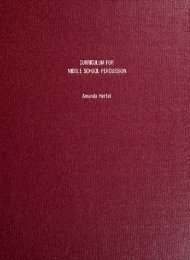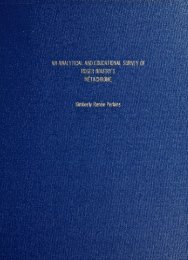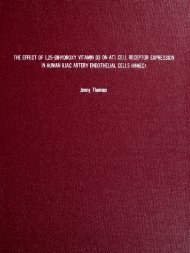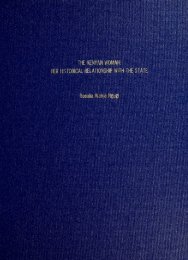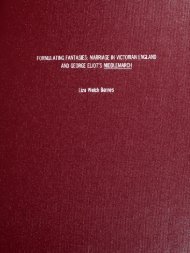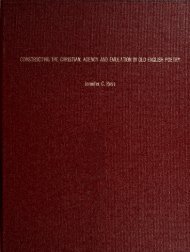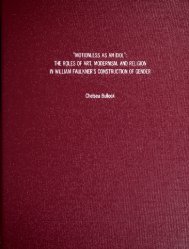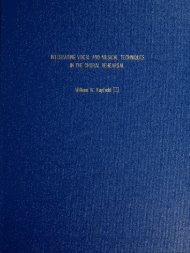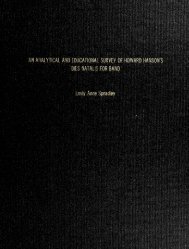The Effect of Aposematic Coloration on the Food Preference of ...
The Effect of Aposematic Coloration on the Food Preference of ...
The Effect of Aposematic Coloration on the Food Preference of ...
- No tags were found...
You also want an ePaper? Increase the reach of your titles
YUMPU automatically turns print PDFs into web optimized ePapers that Google loves.
eetle avoided <strong>the</strong> same type <str<strong>on</strong>g>of</str<strong>on</strong>g> lady beetles in future encounters, indicating initially that colormay have played a role in that avoidance.However, palatable bean leaf beetles, which bear redand black markings similar to those <str<strong>on</strong>g>of</str<strong>on</strong>g> lady beetles, were not avoided, even after <strong>the</strong> chick hadencountered <strong>the</strong> unpalatable lady beetles (Whitmore and Pruess 1982).IV. Abrus precatorius - Potential <str<strong>on</strong>g>Aposematic</str<strong>on</strong>g> PreyAbrus precatorius, also known as rosary pea or crab's eyes, is a vine-like plantcharacterized by <strong>the</strong> presence <str<strong>on</strong>g>of</str<strong>on</strong>g> small seeds (6-7 mm l<strong>on</strong>g) that are bright red with black bases(University <str<strong>on</strong>g>of</str<strong>on</strong>g> Florida 2002).Small groups <str<strong>on</strong>g>of</str<strong>on</strong>g> Abrus seeds develop in pods that open by earlyMarch and begin to drop seeds by late May. <str<strong>on</strong>g>The</str<strong>on</strong>g>se seeds, <str<strong>on</strong>g>of</str<strong>on</strong>g>ten called jequirity beans, are highlypois<strong>on</strong>ous and c<strong>on</strong>tain <strong>the</strong> c<strong>on</strong>centrated toxin abrin. If a seed is swallowed whole, it is probablethat <strong>the</strong> seed will pass through <strong>the</strong> body unnoticed.When ingested by birds, however, <strong>the</strong>jequirity beans may be swallowed whole but are ground in <strong>the</strong> gizzard, resulting in release <str<strong>on</strong>g>of</str<strong>on</strong>g> <strong>the</strong>toxin into <strong>the</strong> body.If chewed or <strong>the</strong> seed coat is penetrated, even <strong>on</strong>e seed is enough to killmost organisms, including adult humans (Hostetler 2001 ).When <strong>the</strong> seeds are ingested and <strong>the</strong>hard shell coat is broken through masticati<strong>on</strong>, abrin is released into <strong>the</strong> subject, causing severegastroenteritis followed by coma and death (Hostetler 2001 ).Within <strong>the</strong> seed, <strong>the</strong>re are tw<str<strong>on</strong>g>of</str<strong>on</strong>g>orms - a and b - <str<strong>on</strong>g>of</str<strong>on</strong>g> <strong>the</strong> toxin, and each form is composed <str<strong>on</strong>g>of</str<strong>on</strong>g> an A and B chain.Once ingested,chain B stimulates abrin to bind to cell membranes, moving <strong>the</strong> complex with chain A into <strong>the</strong>cell cytosol.Chain A <strong>the</strong>n removes adenine from positi<strong>on</strong>s 4 and 324 <str<strong>on</strong>g>of</str<strong>on</strong>g> a specific (28S) rRNA,deactivating ribosomes and inhibiting protein syn<strong>the</strong>sis (Patocka 2001).C<strong>on</strong>sidering thisincredibly noxious nature <str<strong>on</strong>g>of</str<strong>on</strong>g> <strong>the</strong> seeds and <strong>the</strong>ir striking color pattern, itseems evident that <strong>the</strong>ircolor could functi<strong>on</strong> as a deterrent to approaching organisms, although <strong>the</strong> specific predator thatmight be resp<strong>on</strong>ding to <strong>the</strong> signal is unknown.



